MY CURRENT FIRST CHOICE STREAM PATTERNS
Text and images by MC Coetzer
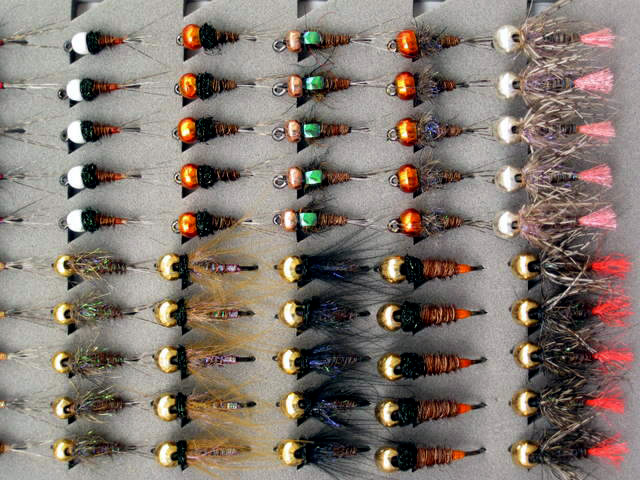
A range of MC's nymphs
DRY FLIES
I tend to fish dry flies almost exclusively on the Cape Streams, simply because I enjoy fishing them more than what I do fishing nymphs. I did however include three nymphs in my selection because there are days when the flows are too high for a dry or when the fish simply refuse to move to the surface. As you can see, I don't rate imitation very highly in Trout flies
for our streams, but feel that functionality combined with suggestive characteristics are far more important.
I generally start the day with a big Para RAB because it will entice lazy fish to strike very positively early in the morning but I find that its effectiveness decreases from about nine in the morning. As soon as I feel that the fish are not eating it well enough or if I get a couple of refusals I switch to the Mini Para RAB. This is my absolute go to fly and it gets fished about seventy percent of the time. It casts well into a moderate wind, lands softly, floats well, is highly visible and the fish love it. 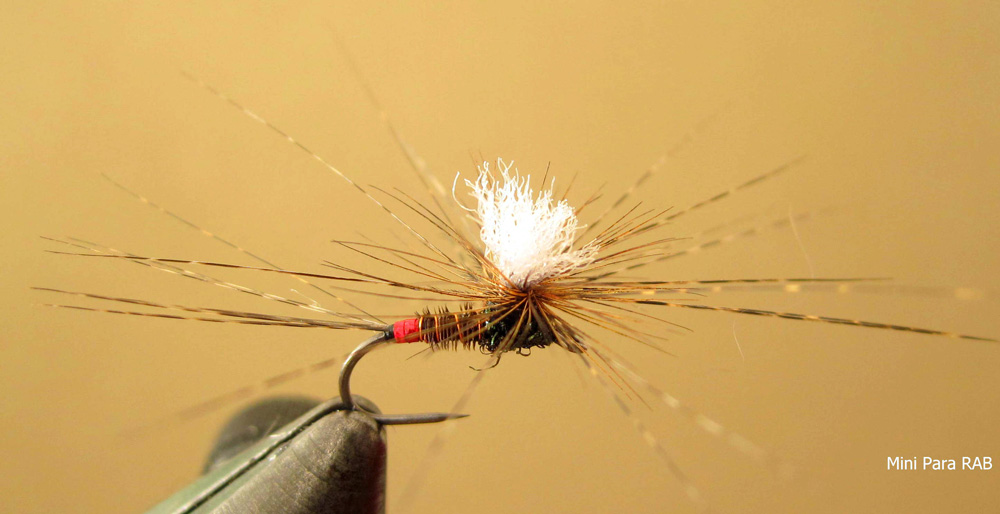
Dressing:
Hook: # 16 Skalka Short Shank dry fly
Tail: Coq de Leon
Tag: Red Holographic Flash
Body: Pheasant Tail Fibres
Post: Poly Yarn
Thorax: Peacock Glister Dubbing
Hackle: Three turns of Brown and one turn of Coq de Leon
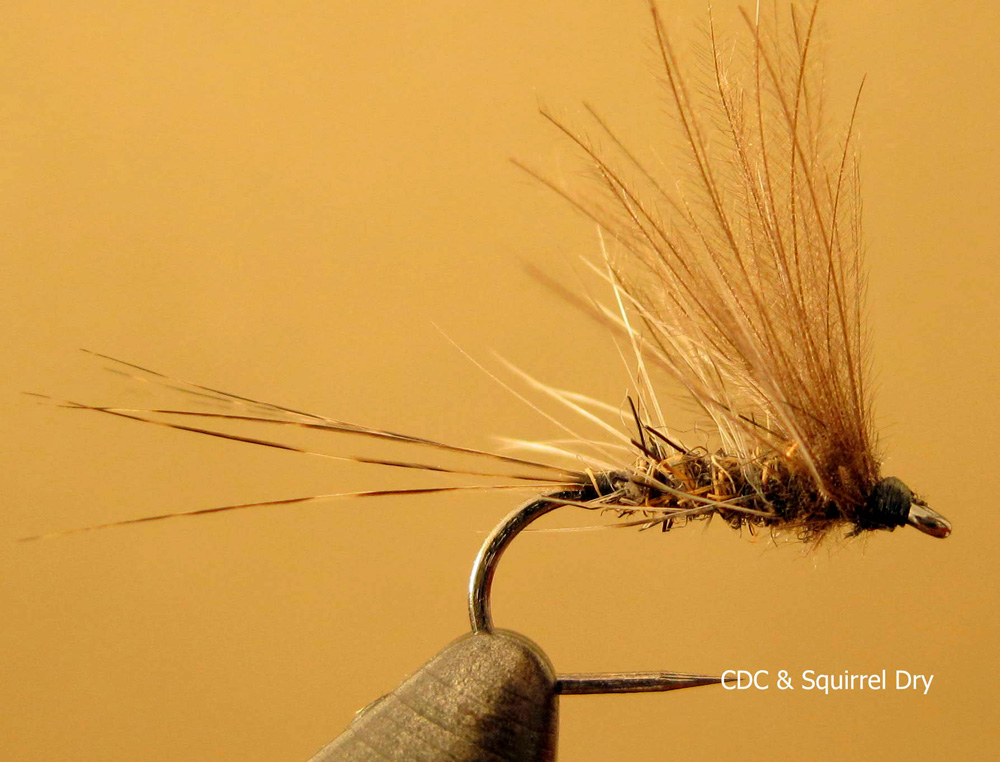
The next pattern is a Squirrel & CDC dry. This sparsely tied natural pattern is more subtle than the RAB and it gets a swim if a fish refuses one of the other patterns or when a fish is spotted in slow water along the margins. It is however not suitable for fast water and will sink almost immediately when it gets trapped in the fast stuff.
Dressing:
Hook: # 16 Skalka Short Shank dry fly
Tail: Coq de Leon
Body: Natural Squirrel
Hackle: Dun Hackle - stripped on the one side, counter ribbed with 8X mono and cut flush with the belly.
Wing & Thorax: Natural Dun CDC - using the split thread technique and again cut flush with the belly.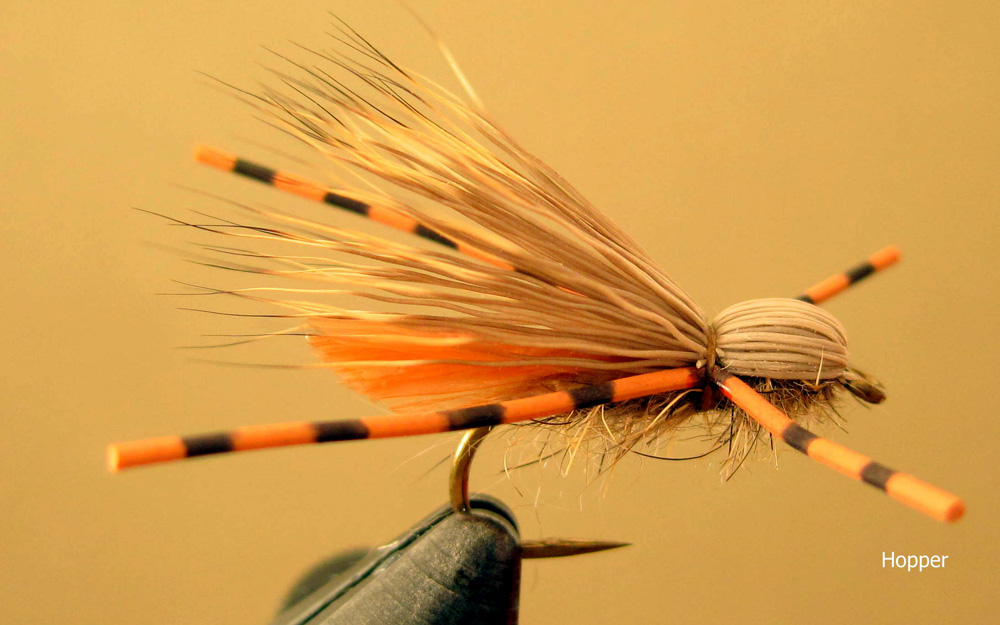
My third choice dry fly only gets fished when I am faced with a very strong South Easter in midsummer. This fairly big Hopper pattern has a body of natural Squirrel to absorb a lot of water. The effect is that the fly becomes quite heavy but because of this it can be cast into the teeth of a strong wind. Another advantage is that it makes a solid "splat" when it hits the water and Trout attack this fly very aggressively. The orange legs are critical and out fish any other colour by a country mile. This pattern only comes out of the box on summer afternoons when the wind becomes too strong for any other pattern but it has turned many average days into great days on the rivers.
Dressing:
Hook: # 12 Mustad Wet Fly
Body: Natural Squirrel
Wing: Orange Crystal Flash and Rust coloured Raffia
Head: Natural Squirrel
Bullet Head and Over Wing: Natural Deer Hair
Legs: Orange Barred Round Rubber
ANT
Here is a very simple sunken ant pattern.
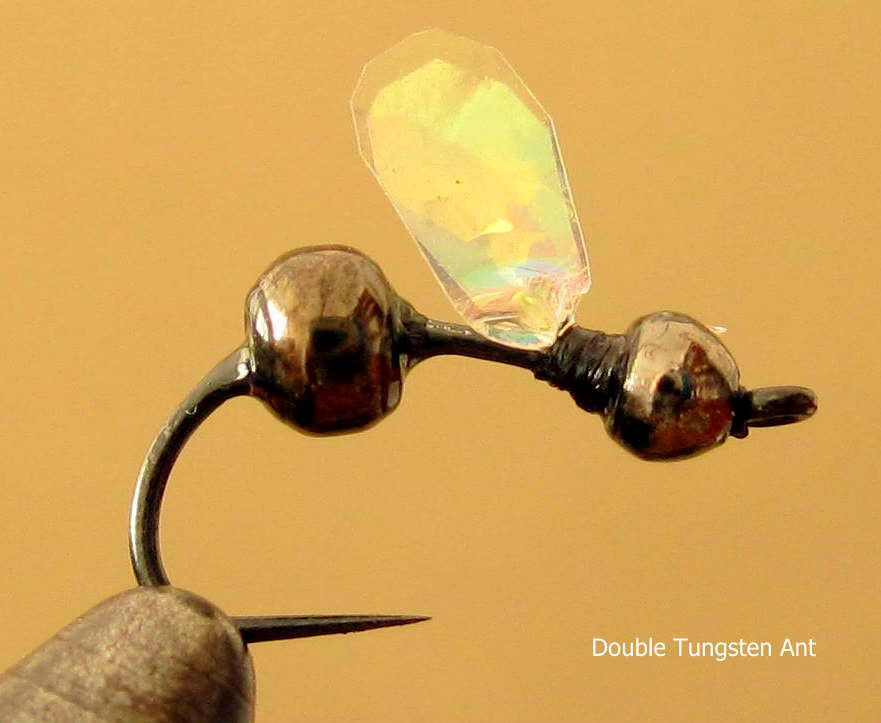
This one is tied on a #18 TMC 206 BL. All it is, is two small tungsten beads and a wing cut from pearl sheeting.
I suppose you could use some white organza for the wing and maybe some sparse black cdc for the legs, but in this small size the tying in area gets a bit cramped and you lose the silhouette.
NYMPHS
My nymphs all have one thing in common and that is the orange hot-spot. I believe that this makes a huge difference to any natural. 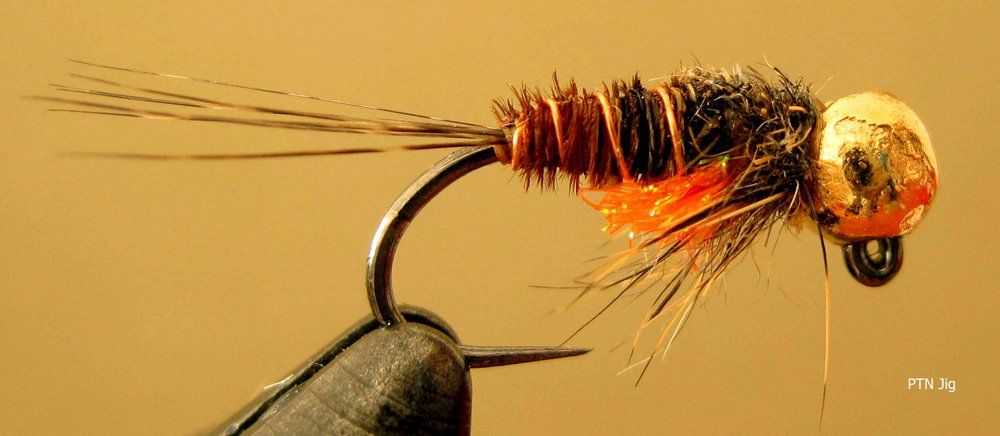
The PTN Jig is mostly fished in combination with one of the other patterns as an anchor fly or on its own when fishing small pockets where the fly has to get down in a hurry. The Hotspot Squirrel Nymph has been around for many years but it is still one of my all time favourite patterns that will take fish in any river. The final pattern (CDC & Squirrel Nymph) is a variation that I was given by a Spanish fisherman. It is essentially the same as the last pattern but it also has the CDC legs which adds a bit more movement and makes it perfect for slightly slower water where sink rate is not a factor.
Dressings:
PTN Jig:
Hook: # 16 Hanak Jig
Bead: Slotted Tungsten
Tail: Coq de Leon
Body: Pheasant Tail Fibres
Rib: Copper Wire
Hotspot: Orange Ice Dub
Thorax: Darker Natural Squirrel
Hotspot Squirrel Nymph:
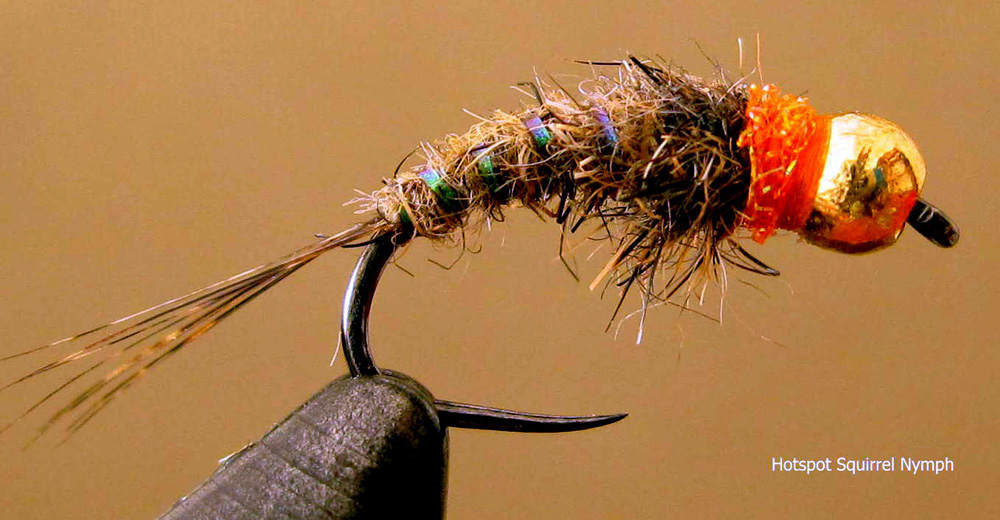
Hook: #16 Knapec Sedge
Bead: Gold Tungsten
Tail: Coq de Leon
Body: Natural Squirrel
Rib: Stretched Hends Crystal Flash
Thorax: Darker Natural Squirrel
Hotspot: Orange Ice Dub
CDC & Squirrel Nymph:
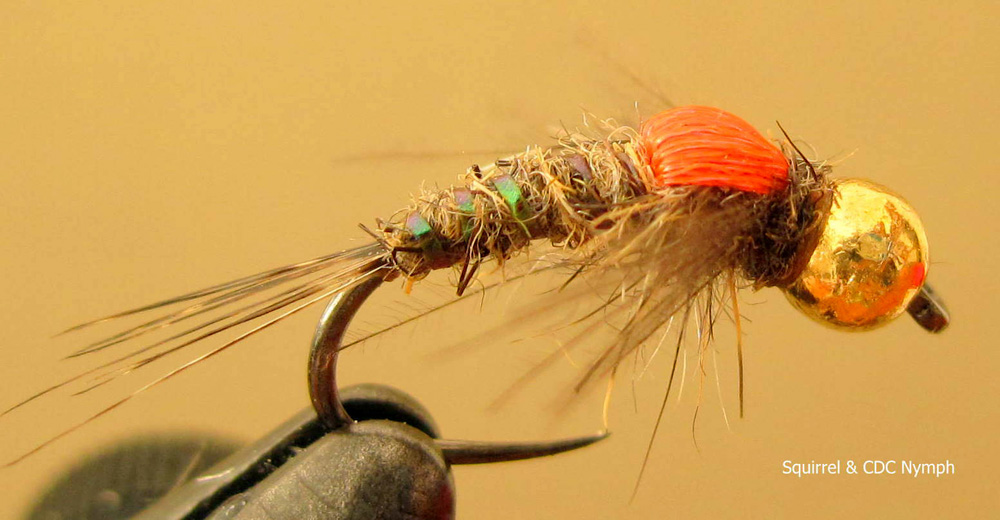
Hook: #16 Knapec Sedge
Bead: Gold Tungsten
Tail: Coq de Leon
Body: Natural Squirrel
Rib: Stretched Hends Crystal Flash
Thorax: Darker Natural Squirrel
Thorax Cover: Fluo Orange Organza
Legs: Natural CDC
GENERAL NOTES
The Jig is used as the top dropper in a two fly combo because it doesn’t hang up easily and it sinks faster than the others. The second application for the Jig is when fishing small pockets where you need the fly to get down before it is sucked out of the pocket – in this application I fish it as a single fly.
The other two patterns are very similar, yet different. The one without cdc is a compromise between sink rate and movement – it sinks faster than the one with cdc, but it has a more buggy appearance than the Jig. This is definitely my favourite nymph pattern. It’s very old and plain, but the fish just love it. The rib is stretched Hends Crystal Flash which gets a UV glow when you stretch it – a Slovak trick. The pattern can also be brushed more aggressively if you want more movement, but then you start compromising on sink rate. When I fished with one of the French anglers on this last trip he was very adamant that the fly must start fishing as soon as possible after entering the water – by this he means that it must get to the fish’s depth fast and then stay there. They use an aggressive tuck cast to achieve this, but fly design is equally important.
The nymph with the cdc is meant for slightly slower water (glides as opposed to riffles or pockets) where sink rate is not that critical and I find that the built in movement of the cdc gets better results when the fly has a chance to “breathe” in the slower flows.
When I still fished competitively I fished dry flies almost exclusively on our rivers. The reason is that I believe dries to be less intrusive than nymphs and as long as your drifts are good you will get many chances at the same fish / same piece of water. You can only plonk a nymph in front of a fish once and if you plonk too close you will spook him and not get another opportunity. In a competition session on the Smalblaar River four fish in a three hour session was generally enough to get a very high placing, so it was vital to make every one of those fish count. I will always fish the small pattern as a first option, but if a fish showed itself, but refused the fly, I will not make another cast at him with the same fly – this is critical but difficult to do. I will very carefully move back about five metres and relax for a couple of minutes. Then I will change the fly to the CDC dry and change my position behind the fish so that I could get the perfect drift, but from a different angle. Nine out of ten times the fish would then simply eat the “new” pattern as it comes over and I suspect it is more a matter of getting a better presentation, rather than the better fly.
If the fish didn’t move for the cdc pattern I would repeat the procedure but change to an aggressive dry – something like a hopper or a big RAB.
MC Coetzer
OBSERVATION
I think this is a particularly well informed and useful article from a deep thinking angler who has represented South Africa at international level. I am extremely grateful to MC for sharing his patterns and his wisdom.
Tom Sutcliffe


